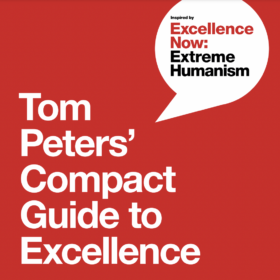8.27.2018 revised 7.9.2021
Tom wants to remind us of the importance of Hard is Soft. Soft is Hard. Here’s what he says:
(“Hard [plans, numbers, org charts] is soft [abstract, readily manipulable]. Soft [people, relationships, culture] is hard [bedrock, lasting].)”
My Life in Six Words
The terms ‘hard facts’ and ‘the soft stuff’ used in business imply that data are somehow real and strong while emotions are weak and less important.”George Kohlrieser, Hostage at the Table: How Leaders Can Overcome Conflict, Influence Others, and Raise Performance
My life in six words: Hard is soft. Soft is hard.
Hard (numbers/plans/org charts) is soft: Plans are often fantasies; organizational charts have little to do with the way the organization actually works; and numbers are readily manipulated. Case in point: “quants” and ratings-agency staffers cleverly packaged and evaluated “derivatives” of valueless mortgages, thus spurring the multi-trillion dollar financial crash of 2007–2008 and beyond.
Soft (people/relationships/culture) is hard: The best “people practices” (caring, training, acknowledging) create the most wholesome, community-minded organizations—and win in the marketplace as well. Effective people practices, design that inspires, customers who are enthralled, vendors who bend over backwards to assist us are all byproducts of a supportive culture nurtured one day at a time.
This was the heart of In Search of Excellence. This is the heart of my work today. This has been the heart of every one of my books. “Hard is soft/soft is hard” has been taken up by some, but I’m afraid it’s not the norm. And as I write, we are beginning to emerge from the grip of COVID-19 and deep social and political unrest. Humane and thoughtful behavior is in fact more important than ever. Far more important!
Google Gets a [B-I-G] [SOFT] Surprise
Project Oxygen [data from founding in 1998 to 2013] shocked everyone by concluding that, among the eight most important qualities of Google’s top employees, STEM [Science, Technology, Engineering, and Mathematics] expertise comes in dead last. The seven top characteristics of success at Google are all soft skills: being a good coach; communicating and listening well; possessing insights into others (including others’ different values and points of view); having empathy toward and being supportive of one’s colleagues; being a good critical thinker and problem solver; and being able to make connections across complex ideas. Those traits sounds more like what gets as an English or theater major than as a programmer. …
“Project Aristotle [2017] further supports the importance of soft skills even in high-tech environments. Project Aristotle analyzes data on inventive and productive teams,. Google takes pride in it’s A-teams, assembled with top scientists, each with the most specialized knowledge and able to throw down one cutting-edge idea after another. Its data analysis revealed, however, that the company’s most important and productive ideas come from B-teams comprised of employees that don’t always have to be the smartest people in the room. Project Aristotle shows that that the best teams at Google exhibit a range of soft skills: equality, generosity, curiosity toward the ideas of your teammates, empathy and emotional intelligence. And topping the list: emotional safety. No bullying. …
“[Tech] billionaire venture capitalist and ‘Shark Tank’ TV personality Mark Cuban looks for philosophy majors when he’s investing in sharks most likely to succeed.”Source: Valerie Strauss, “The surprising thing Google learned about its employees—and what it means for today’s students” (Washington Post)
Bonus: All Hail the Liberal Arts
AT GRADUATION: Business and professional degree holders in general [MBAs, engineers, lawyers, etc.] have higher interview and hire rates, and higher starting salaries, than new liberal arts grads.
YEAR 20: Liberal arts grads have risen farther than their biz-professional degree holder peers. At one giant tech firm, 43 percent of liberal arts grads had made it to upper-middle management compared to 32 percent of engineering grads. At one giant financial services firm, 60 percent of the worst managers, according to company evaluations, had MBAs, while 60 percent of the best had only BAs.
Source: Henry Mintzberg, Managers Not MBAs: A Hard Look at the Soft Practice of Managing and Management Development,
More/Sample among these:
The Fuzzy and the Techie: Why the Liberal Arts Will Rule the Digital World, by Scott Hartley
You Can Do Anything: The Surprising Power of a “Useless” Liberal Arts Education, by George Anders
Sensemaking: The Power of the Humanities in the Age of the Algorithm, by Christian Madsbjerg
Range: Why Generalists Triumph in a Specialized World, by David Epstein
From Rich Karlgaard’s THE SOFT EDGE: WHERE GREAT COMPANIES FIND LASTING SUCCESS:
I believe the business world is at a crossroads, where hard-edged people are dominating the narrative and discussion. … The battle for attention and money boiling inside most companies and among most managers is that between the hard and soft edges. …
“Far too many companies invest too little time and money in their soft-edge excellence. … The this mistake has three main reasons:
“1. The hard edge is easier to quantify. …
“2. Successful hard-edge investment provides a faster return on investment. …
“3. CEOs, CFOs, chief operating officers, boards of directors, and shareholders speak the language of finance. …
“Here’s the case for investing time and money in your company’s soft edge:
“1. Soft-edge strength leads to greater brand recognition, higher profit margins, … [It] is the ticket out of Commodityville.
“2. Companies strong in the soft edge are better prepared to survive a big strategic mistake or cataclysmic disruption …
“3. Hard-edge strength provides a fleeting advantage. [It] is easier to clone than the soft edge.”
1982-2021: In Search of Excellence/Excellence Now: Extreme Humanism
Hard is soft. Soft is hard.
“Hard [plans, numbers, org charts] is soft.
“Soft [people, relationships, culture] is hard.”
Q.E.D. (IMHO.)





